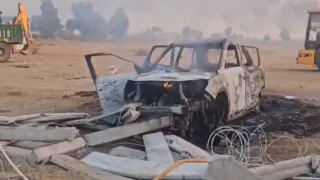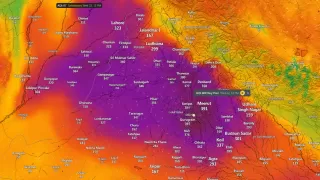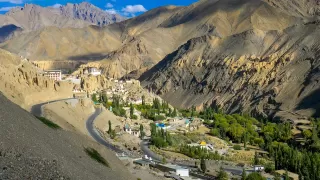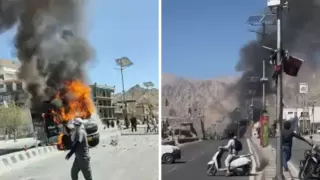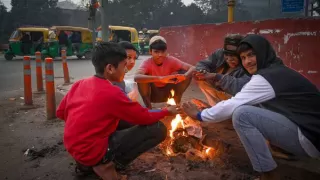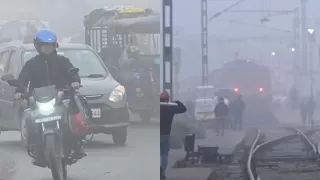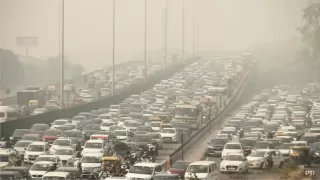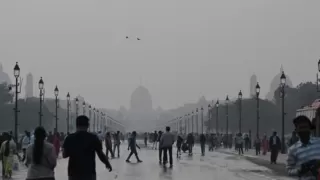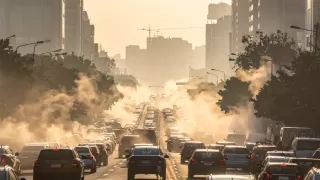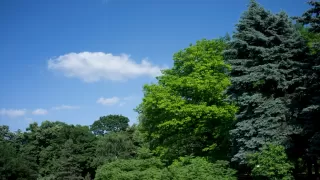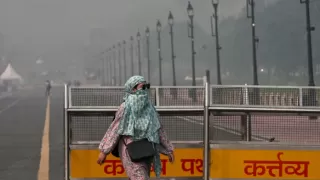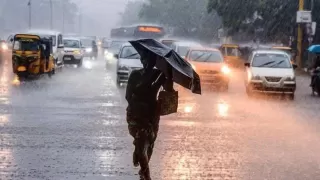New Delhi, October 22, 2025 – With the onset of winter, North India is once again trapped in the web of toxic air. According to the latest report from Microsoft Weather, Delhi's Air Quality Index (AQI) has reached over 400, indicating 'Very Poor' levels. Pollution levels in neighboring cities like Lahore (AQI 323), Ludhiana (299), Kanpur (237+), Lucknow (270+), and Agra (293+) are also extremely worrying. The purple and red hues spreading across the Indo-Gangetic plain clearly indicate that millions of people are now battling for air. Experts say this is the result of human negligence, which is not only destroying nature but also posing a deadly threat to future generations.
Looking at the map, the AQI is hovering between 150 and 400 in most parts of Uttar Pradesh, Punjab, Haryana, and Rajasthan. For example, in cities like Patiala (366), Ferozepur (334), Jalandhar (167), Amritsar (335), and Gorakhpur (178), the air is so polluted that going outside can prove fatal. In the eastern regions, Varanasi (178), Prayagraj (253), and Patna (276) are also not spared from this crisis. While some parts of South India, like Chennai and Bengaluru, are experiencing a respite with AQIs between 50 and 100, the overall picture is worrisome. This map, based on real-time data from Microsoft Weather, shows that the center of pollution is concentrated in Delhi-NCR and the Punjab-Haryana border.
AQI level of major cities
| City | AQI Level | Category |
|---|---|---|
| Noida | 393 | Hazardous |
| Delhi | 400 | Hazardous |
| Ghaziabad | 393 | Hazardous |
| Gurugram | 391 | Hazardous |
| Meerut | 391 | Hazardous |
| Faridabad | 391 | Hazardous |
| Ludhiana | 299 | Very Unhealthy |
| Agra | 293 | Very Unhealthy |
| Fatehpur | 293 | Very Unhealthy |
| Lahore (PAK) | 323 | Hazardous |
| Jalandhar | 167 | Unhealthy for Sensitive Groups |
| Deoband | 167 | Unhealthy for Sensitive Groups |
| Jaipur | 153 | Unhealthy for Sensitive Groups |
| Udhampur | 153 | Unhealthy for Sensitive Groups |
How are humans destroying nature?
Human activities are the primary cause of this destruction. The biggest culprit is industrial emissions – factories, cement plants, and thermal power stations in Delhi-NCR contribute to smog, releasing PM2.5 and PM10 particles into the air. Furthermore, the growing vehicular network – smoke from roads carrying millions of vehicles daily – is poisoning the air. Crop burning is another major culprit; farmers in Punjab and Haryana clear their fields by burning stubble, which leads to peak pollution in September and October. Even small actions like dust from construction, burning domestic fuel, and burning garbage are disrupting nature's balance. Weather irregularities due to climate change – such as reduced wind flow – trap these pollutants, exacerbating the problem. In short, in the name of development, we are cutting down forests, polluting rivers, and poisoning the air, which is slowly killing the Earth's lungs.
What will be its adverse effects?
The effects of this pollution are devastating, both immediately and long-term. In the immediate term, respiratory diseases like asthma, bronchitis, and pneumonia are on the rise. Last week alone, 20% of hospitalizations in Delhi were for pollution-related complaints. Children, the elderly, and heart patients are most at risk – according to the WHO, air pollution causes 1.6 million deaths in India each year.
The long-term effects are even more dire. Pollutants leaching into soil and water are destroying crops, potentially leading to food shortages. Acid rain is killing forests, destroying biodiversity, and putting species like bees and birds on the brink of extinction. Globally, it is accelerating climate change – melting glaciers, increasing floods and droughts will be natural consequences. The economic losses are worth billions of dollars: reduced productivity, increased health costs, and impacts on tourism. If this trend continues, many cities in North India could become uninhabitable by 2050.
Governments implement measures like "odd-even" or "school closures" every year, but root-level solutions are needed – green energy, electric vehicles, and stricter laws. Will we be able to save our air, or will this warning go unheeded? Time is running out.
This image is not just a warning, but a wake-up call. Humanity, once considered life-giving, has suffocated nature through its greed and carelessness. If we don't wake up now, clean air will remain a dream for the next generation.Now is the time to ask ourselves: are we leaving life behind in the race for development?
(This report is based on Microsoft Weather data as of October 22, 2025. Health advice: Wear a mask, stay home, and use a humidifier.)



